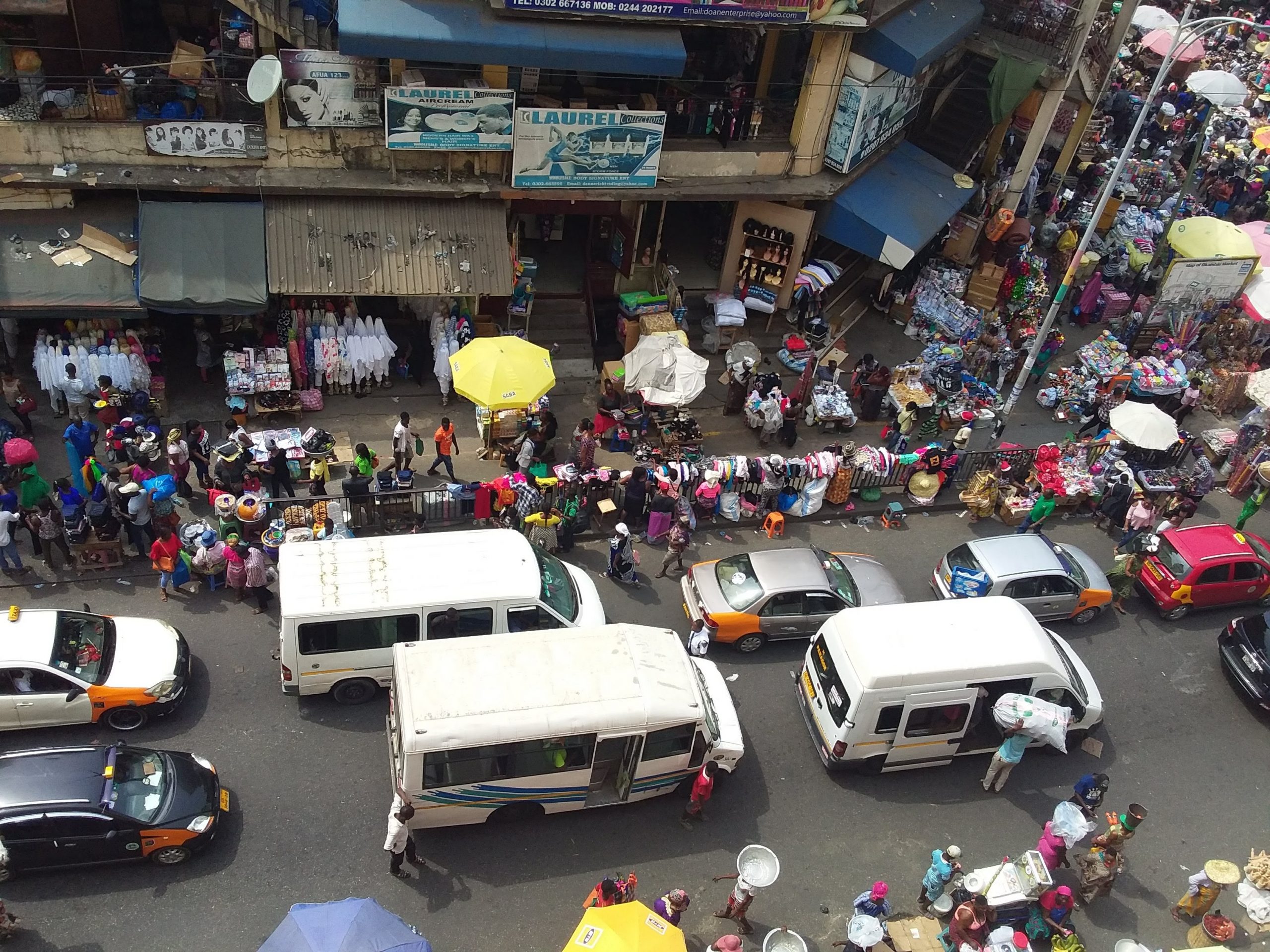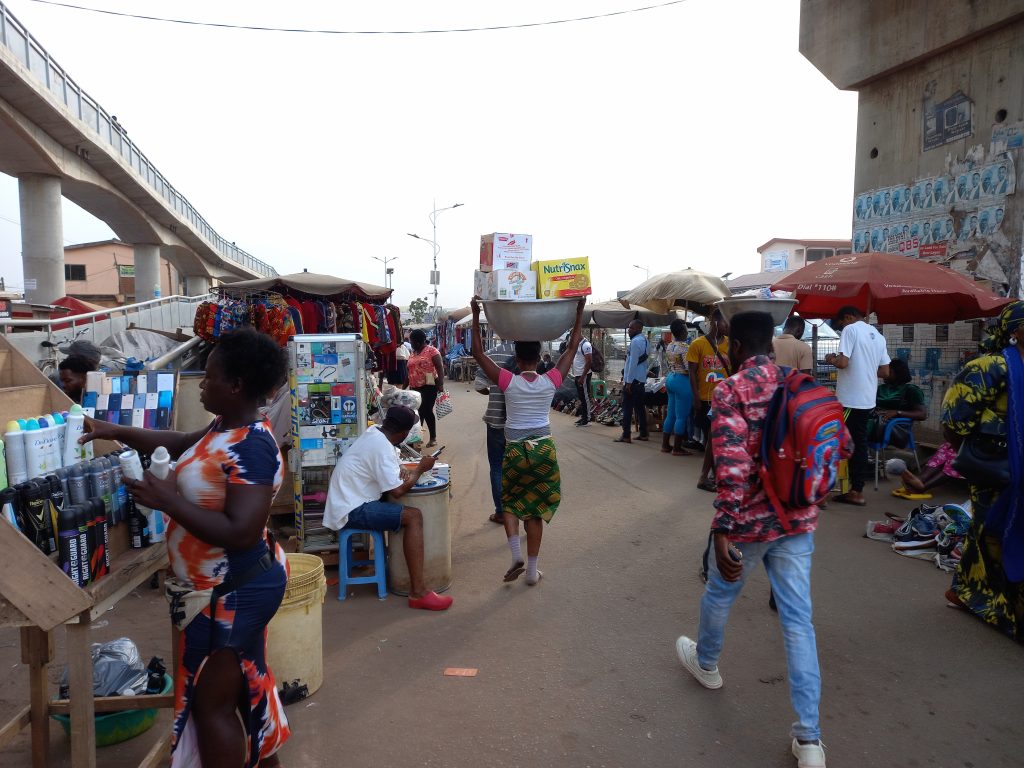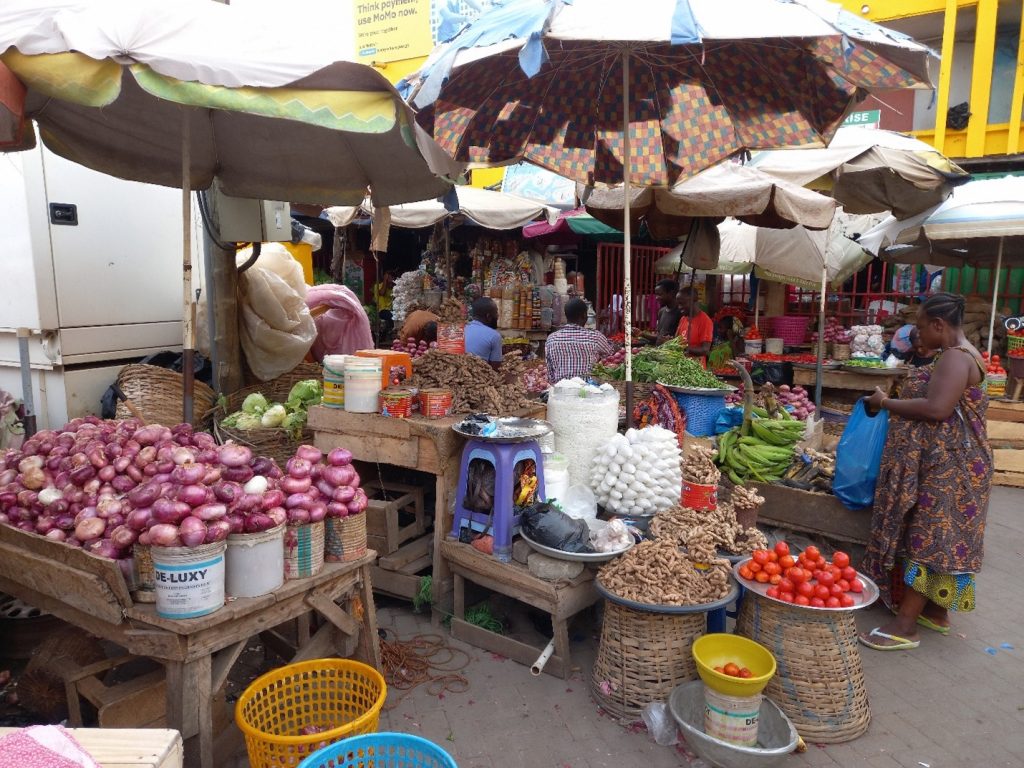Hard pressed but not crushed: A story of resilience and adaptation to COVID in Ghana

A typically busy street in Ghana’s capital, Accra [Photo credit: Louis Hodey]
Written by: Louis Hodey
The COVID-19 pandemic has killed and destroyed – not only lives – but livelihoods as well. The COVID-19 crisis has disrupted food systems in Ghana since its emergence in the country in March 2020. According to the United Nations World Food Programme, the socio-economic burden imposed by COVID-19, particularly through restrictions on social and commercial activities, appears to be more devastating than the actual health burden of the virus in many countries. The story of the disruptive consequences of the crisis on food systems and livelihoods have been told worldwide. Yet, these stories are not the same for all societies and sectors. The recent APRA publication ‘A Multi-Phase Assessment of the Effects of COVID-19 on Food Systems and Rural Livelihoods in Ghana‘ explores these differential effects in Ghana. This blog explores the findings of this report.
In Ghana, evidence abounds that the impact of the COVID-19 crisis cuts across economic sectors, social strata, and geography, though the severity of impact is undoubtedly not the same. Earlier studies by the Ghana Statistical Service suggests that the pandemic has had severe consequences for agribusinesses in Ghana. Particularly, the demand and supply shocks, as well as the operational challenges that confronted agribusinesses in the country during the implementation of containment and lockdown measures, lingered even after the initial lockdown was lifted. It was estimated that 77.4% of households in Ghana experienced income reductions, 78,412 agribusiness workers were laid-off, and 267,211 experienced wage reductions during the post-lockdown period from May 2020 to January 2021 (Ghana Statistical Service, 2021).
What has been the effect of the COVID-19 crisis on the livelihoods and food systems of rural farmers whose vulnerability to shocks appear the greatest? Undoubtedly, the vulnerability and resilience of food systems and rural livelihoods were brought into sharp focus by the COVID-19 crisis. As the crisis continues to disrupt livelihoods and food systems globally, key questions on country- and region-specific impacts of the pandemic must be answered. This blog highlights outcomes of APRA’s study which investigated the impact of the crisis on food systems and rural livelihoods in south-western Ghana. Data for this assessment is taken from three waves of telephone surveys and interviews involving a sub-sample of respondents who previously participated in panel studies by APRA on agricultural commercialisation and livelihood outcomes in south-western Ghana. Based on a mixed-methods design involving household telephone surveys and qualitative interviews, the APRA Ghana study made the following findings.

What have been the impacts of the COVID-19 pandemic on food systems and livelihoods?
Though the rate of reported COVID-19 infections appears quite low in the study area, the livelihood impacts were significant. Our findings show that the global crisis continues to impose adverse impacts on rural livelihoods and food systems. Most households in the study, for example, reported having experienced significant hardship and vulnerability in the form of restrictions on movements, reduced participation in farming and business activities, rising costs of transportation, perception of having reduced control over their own lives, decline in food availability and consumption, and a generally rising costs of living, culminating in food and nutrition insecurity concerns. Overall, as a direct impact of the pandemic, more than a half of the study participants reported having reduced the quantity and variety of food eaten due to a lack of money or other resources. Further, on a scale of 1-10, individual’s perceived control over their own lives declined from 5.3 in the pre-COVID-19 period to 3.9 by January 2021.
Further, the study found that the impact of the pandemic differed across gender and demography. Women and children appeared to be the hardest hit by the pandemic. For instance, schools were closed for almost a year which affected teaching and learning since remote learning opportunities were almost non-existent in the study area, thus affecting the education of children. This is expected to further widen the educational inequality gap between rural and urban children. Women, particularly those engaged in cross-border trade, also suffered some trade losses. Further, the extra burden of childcare during the school closures impacted women more heavily than men.

How did households survive the pandemic?
Households in the study appear to be showing remarkable resilience in the face of very little or, in most cases, no external assistance. Some farming households have been coping with the crisis by intensifying their engagement in non-farm business activities, reducing food and non-food consumption, and relying on savings. Further, we found that to escape the consequences of border closures on their livelihoods, traders diverted their activities from cross-border destinations to regional and national markets. Additionally, to mitigate the impact of the cost of sanitary items and other personal protective equipment, and to generate extra income, households embarked on the production of face masks, alcohol-based hand sanitisers, handwashing soaps, and makeshift hand washing buckets. Indeed, these together with enhanced hygiene practices such as regular washing of hands with soap under running water, and the wearing of face masks, appear to have minimised the health and the socio-economic burden of the COVID-19 crisis and other airborne and hygiene-related diseases among the study participants.
What challenges are lingering?
Even though households appear to have shown remarkable resilience in the face of the negative impacts of the pandemic, some shocks persist and may potentially impose greater livelihood challenges for smallholder farmers. First, food inflation continues to be on the rise, with consequences for nutrition and food insecurity. Second, access to farm inputs remain generally constrained due to increasing input prices and severe financial difficulties resulting from the COVID-19 crisis. Finally, Ghana’s land borders have remained closed since March 2020, further exacerbating the socio-economic consequences for households whose livelihoods heavily depend on cross-border trade. These impacts are far from over and may linger in the coming years; hence the need for policy to address them to safeguard lives and livelihoods.
What are the implications of the study for policy and practice, and the way forward?
These findings have relevant implications for the government’s poverty reduction strategy, especially in the design and implementation of COVID-19-related livelihood support programmes to safeguard the sustenance of poor and vulnerable households. Indeed, safeguarding the lives and livelihoods of the most vulnerable people is important in minimising the impact of the COVID-19 crisis worldwide. Given the lingering challenges imposed by the pandemic on livelihoods, there is a need for coordinated recovery efforts focused on building the resilience of food systems by targeting the worst affected groups such as smallholder farmers, women, and children.
References
GSS (Ghana Statistical Service) (2021) Summary Report on Impact of Covid-19 on Agribusinesses in Ghana. Accra: Ghana Statistical Service. Available at: https://www.gh.undp.org/content/ghana/en/home/library/ghana-covid-19-agribusiness-trackersummary-report.html
Hodey, L.S. and Dzanku, F.M. (2021) A Multi-Phase Assessment of the Effects of COVID-19 on Food Systems and Rural Livelihoods in Ghana. APRA COVID-19 Country Report. Brighton: Future Agricultures Consortium. Available at: https://opendocs.ids.ac.uk/opendocs/handle/20.500.12413/16990
To hear more about APRA’s research findings on COVID-19, join the e-Dialogue on February 9th, 2022. Learn more and register, here.
Read about previous APRA research on COVID-19 in Ghana in the following blogs:
